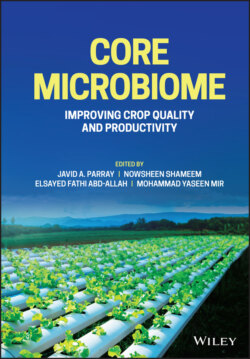Читать книгу Core Microbiome - Группа авторов - Страница 49
3.5.1 Multi-omics Approaches Used to Mitigate Abiotic Stresses in Medicinal Plants
ОглавлениеMulti-omics approaches would help in dissecting the mechanism of combating stress by these plant–microbe interactions (Dubey et al. 2020). Plant–microbe interaction improves metabolic activity and resistance against stresses (Nguyen et al. 1997). For this purpose, molecular, biochemical, and physiological aspects are important to understand complex processes. At the same time, we need to determine the process of stress mitigation in medicinal plants for higher productivity (Meena et al. 2017). Stress alleviation is an important and challenging issue and gets results by altering crop genetics and it requires extensive breeding efforts (Grainger and Rajcan 2014). Low genetic diversity and temperature fluctuation make breeding efforts more challenging (Manavalan et al. 2009). Molecular marker breeding is effective to speed up tolerance in cultivars. For this purpose, the availability of molecular markers that are tightly linked with genomic loci that are responsible for tolerance is important for selection. With the new advancement of DNA sequencing and metabolic profiling technology, a new era of phytochemical genomics has emerged. In this new technology, the biosynthetic mechanism, regulation, function, and evolution of phytochemicals are determined by the integration of genomics and omics technology, such as metabolomics, proteomics, and transcriptomics (Saito 2013). Endophytic actinomycetes are the source of producing natural products with antifungal activity (Passari et al. 2015). Transcriptome data of Catharanthus roseus recognized genes involved in monoterpenoid indole alkaloid biosynthesis. Furthermore, these gene products have been established to be cytochrome P450 hydroxylating aspidosperma alkaloids at 19 positions (Giddings et al. 2011) and iridoid synthase reductively converting 10-oxogeranial scaffold (Geu-Flores et al. 2012). Morphine biosynthesis genes are identified by the omics technique in opium poppy (Papaver somniferum) (Hagel and Facchini 2010. Multi-omics approaches such as genomics, transcriptomic, proteomics, metabolic pathway, and phenomics integrative studies are compulsory to study plant and microbes and their interaction with environment, and generated data could be helpful in mitigating abiotic stresses. It will also be helpful to report microbial groups for their proper working and functions in the soil.
